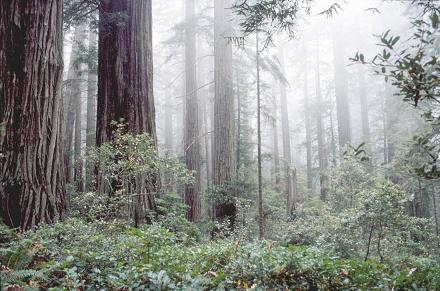|
Climate Change in Coast Redwood Forests
Despite being buffered by a cool humid coastal climate, future changes in climate may affect the coast redwood forest in direct and indirect ways. One of the most important climate-related factors that influences fire risk and the floral and faunal character of the coast redwoods is the incidence of summer fog. Some sites receive a great influx of moisture during the otherwise dry summer from fog drip, but the cooler temperatures and reduced evapotranspiration along the overcast coast are probably a more widespread and influence on fire regimes.
|
 |
The interesting relationship between fog-stratus and regional temperature is known to those who have lived on the redwood coast for any length of time. Cool water upwells offshore as the California current flows southward. Warmer air moving over this humid surface is chilled and condenses. When interior temperatures rise, this marine layer of air is pulled inland and gets forced against the coastal mountains and is vertically contained under an inversion associated regional high pressure. Given this persistance of this pattern during most year's fire season, the local occurrence probability of fog-stratus helps define the fire hazard as well as the vegetation that is found there.
 |
The incidence of coastal fog-stratus varies over time. Less fog was recorded during the fire seasons during the 1920s and 1930s and 1950s, while fog was common during the 1890s, 1910s, 1940s and 1970s. It is common to observe the strongest fire activity in the interior Klamath mountains on days when this coastal fog-stratus pattern is best developed. Variation in fog-stratus over centuries can alter the fire occurrence probabilities which affect the importance of seeding trees, such as Douglas fir and patterns of biodiversity.
Ongoing research models the incidence of fog-stratus in relation to historical fire activity and vegetation. This knowledge will help managers understand the specific climatic mechanisms that create patterns of fire hazards and how fire-related risks might change over time. |
The 2008 fire season has been extraordinary in northern California. From space, the ancient relationship between coastal fog that ameliorates the fire hazard, and interior burning, indicated here by grey smoke, is well illustrated (below; The top of the image is near the Oregon-California border, Lake Tahoe is in the right center and Monterey is at bottom center). Note the pattern of where coastal fog usually occurs. The incidence of fog in northwestern California (upper left) is more interior than along the Medocino coast (center). These mid-day images under-represent the influence of early morning fog, which also contributes to higher fuel moistures and vegetation pattern.
Related Pages:
Steve Norman
|
|

